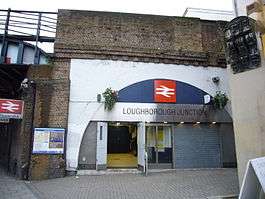Loughborough Junction
Loughborough Junction is an area of South London, in the London Borough of Lambeth, which is located between Brixton, Camberwell and Herne Hill. It is centred on a rail junction consisting of seven railway bridges, six of which can be seen at once from the centre of the junction. The source of this area's name is Loughborough Junction railway station; 'Loughborough' because the area was once the location of Loughborough House, the residence of Henry Hastings, 1st Baron Loughborough, which was previously the Manor House of Lambeth Wick.[1]
History
Toponymy
The name "Loughborough Junction" relates to the railway junction immediately to the north of the station of the same name, where spurs diverge from the north–south line that forms the Wimbledon Loop part of the Thameslink network, to connect with the east–west South London Line. The section of the South London Line that passes through Loughborough Junction is one of the major cross-London rail freight routes, carrying traffic from the Channel Tunnel and the ports of the Thames Estuary to destinations west and north of London.
Governance
Loughborough Junction is situated in two wards, Brixton Coldharbour and Herne Hill. The 2018 council elections saw the Labour Party win 5 out of the 6 seats up for election with The Green Party winning 1 of the 6.
The Loughborough Junction Action Group (LJAG) was formed by volunteer residents in 2008 with a view to regenerate the area. LJAG worked with the council to form a masterplan for the area, with consultation events held with local residents to ascertain how they would like the area to be improved. These plans were developed during 2013.[2]
Geography
Loughborough Junction can be found within the postal codes of SE5 and SW9, which shows its southern central position. It is between Herne Hill, Brixton and Camberwell. The main road passing through it is Coldharbour Lane, which runs from central Brixton all the way to Camberwell.
The area itself deteriorated over the years, due partly to planning blight related to transport schemes that were never realised and to the neglect of its housing stock by both private and council landlords. Drug- and gang-related problems resulted in the closure of several pubs in the area. More recently two of these pubs have been renovated. The Green Man is now a 'skills hub' run by Lambeth council. The Warrior was for a short time used for occasional pop-up cultural events—particularly the "7 Bridges" project, a locally-based initiative to improve the area—but has now been redeveloped as a Tesco Metro supermarket.
Loughborough Junction is home to Whirled Arts, which runs a cinema in the railway arches on Hardess Street, showing mainly arthouse and foreign-language films, and also hosting literary and musical events. There are also several art galleries and artists' studios in the immediate area. The arch adjacent to the entrance of Loughborough Junction station is home to The Beanery, an independent coffee shop and wine bar.
The property in the area is a mixture of Victorian and Georgian mansion blocks and town houses, and local authority housing estates. The main estates are the Loughborough Estate, by modernist architect Sir Leslie Martin (designer of the Royal Festival Hall), the Angell Town Estate and the Moorlands Estate.
The area is served by four primary schools: Loughborough Infants and Juniors, Crawford Primary, St Saviours and Jessops.
To the south of the area is Ruskin Park, situated on a hill with views over central London, where there are tennis courts, enclosed courts for ball games, a children's playground and a large area used for football matches on the weekends. There is also a large dog-free area and a flower garden.
The neighbouring areas of London are Brixton, Camberwell, Denmark Hill, Herne Hill, North Dulwich and Stockwell.
In fiction
The area features in the novel by Stella Duffy The Room Of Lost Things, set in a dry cleaners on Coldharbour Lane.[3]
Crime
In a 2003 London Evening Standard journalist David Cohen described Coldharbour Lane, on which Loughborough Junction is situated, as the most dangerous street in the most dangerous borough in London. The headline asked whether the street is 'the most dangerous in Britain'. [4] Loughborough Junction was for a time territory of GAS Gang, considered by the police to be one the most dangerous gangs in South London in 2012.[5][6][7]
Three graffiti artists died when they were hit by a train at Loughborough Junction station in June 2018. The three men's deaths sparked controversy after a former Transport for London (TfL) board member Brian Cooke described the dead men as "common scum who cost the railway millions and keep fares high".[8]
Notable people
- Former British Prime Minister John Major lived at 144 Coldharbour Lane from 1955 to 1959.[9] Major Close is named after him.[10]
References
- Brixton Guide
- http://www.lambeth.gov.uk/sites/default/files/Loughborough_Junction_Framework_Plan8.pdf
- https://www.theguardian.com/books/2009/feb/21/room-of-lost-things-review
- Evening Standard, 30/01/2003 Page: 16 Nearly 15,000 stabbings, robberies, muggings and even murders ... most linked to 300 yards where £1m of crack cocaine is dealt each month. Is this the most dangerous street in Britain? INVESTIGATION: The Standard spends 24 hours in the London borough where the police fight their biggest battle against crime By: DAVID COHEN
- "Behind the story". The Times. 27 March 2012. ISSN 0140-0460. Retrieved 22 August 2019.
- https://pdfs.semanticscholar.org/b014/f2817ecaa01f35f8fdd273529951ad0a0076.pdf
- "700 police launch dawn raids targeted at notorious Brixton-based gang". Evening Standard. 30 January 2014. Retrieved 22 August 2019.
- https://www.bbc.co.uk/news/uk-england-london-44534102
- John Major (1999). John Major: The Autobiography. Harper Collins. p. 16-7.
- "There's a John Major road ahead - but even he hasn't noticed". Evening Standard. 24 October 2007. Retrieved 18 April 2020.
External links
- 360 panoramic view of loughborough junction at Urban75
- LJ4D project - a virtual 3d model which documents the evolution of the Loughborough Junction area through history


